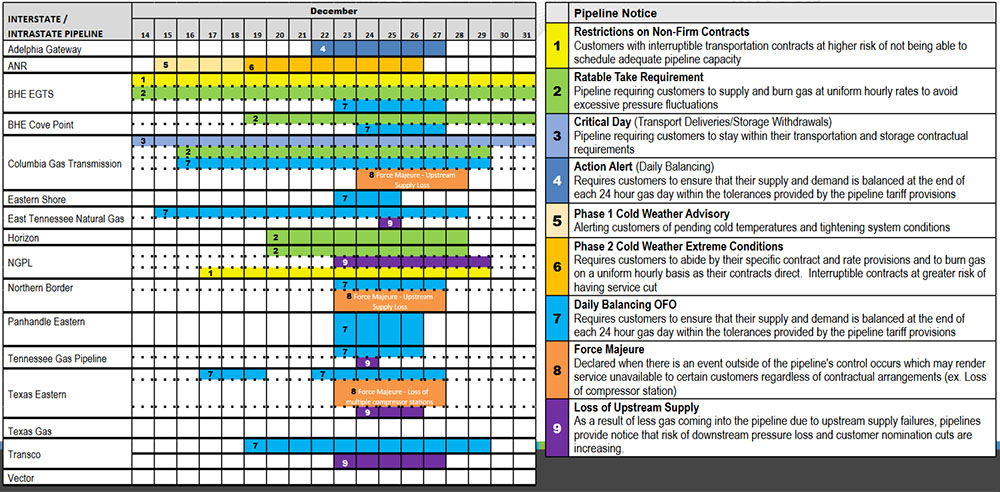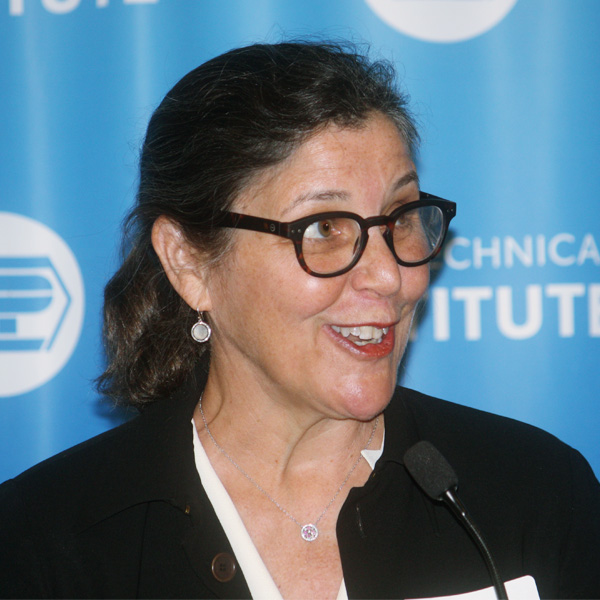Gas Supply Issues During December Storm Reviewed
PJM presented the Operating Committee a review of the issues that contributed to insufficient natural gas supplies during Winter Storm Elliott, one of the leading causes of generation being offline during the storm.
Gas pipelines took numerous actions in the days leading up to the storm, PJM’s Brian Fitzpatrick said, including restrictions on non-firm contracts and requiring daily balancing of supply and demand. But the actions were insufficient as the storm rolled in and caused force majeure declarations and losses in upstream supply. PJM was aware of the precautionary actions through its daily updates with pipeline operators, however the scale of the production loss was unforeseen, he said.
“We’ve never seen that level of supply loss in the history of Marcellus and Utica,” Fitzpatrick said of the gas producing regions.
One stakeholder said insufficient gas supply is an issue for other RTOs as well, in part because the reliability analyses conducted by pipeline operators are minimal. Pipelines were originally sited to provide fuel for building heating, rather than for delivery to gas-fired generators. With the future of gas uncertain, the stakeholder said, it’s unlikely there will be sufficient investment to simultaneously meet both needs.

Though the majority of generators that experienced outages related to gas fuel supply had non-firm delivery contracts, many generators with firm fuel also experienced interruptions. On Dec. 24, the day with the most outages, generators with non-firm fuel accounted for nearly half of offline capacity by percent of installed capacity (ICAP), while those with firm fuel represented more than a quarter.
Mike Bryson, PJM senior vice president of operations, said PJM generators with all forms of gas supply contracts saw their deliveries curtailed. The RTO is exploring ways of addressing the issue in its critical issue fast path (CIFP) proposal. (See PJM Presents More Detail on CIFP Proposal.)
“This needs to be part of a flexibility attribute going forward,” he said.
Gregory Poulos, executive director of the Consumer Advocates of PJM States (CAPS), questioned whether there will be similar analysis on other major causes of forced outages during Elliott, noting that boiler issues across generation types accounted for more offline capacity than fuel supply for gas generators alone. Fitzpatrick said physical failures constituted around two-thirds of outages and will be the topic of future presentations.
Proposals Seek to Address Transmission Outage Coordination
Stakeholders continued discussion on two proposals to address how PJM and utilities coordinate extended transmission outages. The proposals seek to avoid the surge in congestion pricing caused by line work in Virginia’s Northern Neck peninsula. (See “Transmission Outage Coordination Proposals Discussed,” PJM OC Briefs: March 9, 2023.)
A joint package from PJM, DC Energy and Public Service Enterprise Group (NYSE:PEG) would direct RTO staff to review approved Regional Transmission Expansion Plan (RTEP) projects for any extended outages that may be required and work with the utility to evaluate the impact of any such outages and expand outage information shared by PJM. Upgrades to facilities may be considered if outages are expected to cause significant operational issues.
The Independent Market Monitor’s proposal would aim to identify congestion impacts in advance of projects being approved and request proposals from TOs. It would also treat a request to reschedule an outage as a new request or as a late submission if TOs try to reschedule too far out, seek to reduce or eliminate approval of outage requests after FTR bidding opens and prevent TOs from bypassing rules for long duration outages by breaking them into smaller segments.
Both proposals require that enhanced rating information be consistent with FERC Order 881, which is set to be implemented by July 12, 2025.
Jim Davis, of Dominion Energy (NYSE:D), said the Monitor’s proposal is overly prescriptive and approaches transmission upgrades solely from a markets perspective without taking construction realities into account. Upgrading a large line in one project without segmenting it could create significant impacts on reliability and markets, he said. Other provisions in the Monitor’s proposal would slow the outage process further and increase the risk of projects not being completed on time, he said.
“We as transmission owners need this flexibility because the transmission outage process is dynamic … especially as conditions change in the real time. As for the [Monitor’s] recommendation that PJM not permit transmission owners to segment long duration transmission outages, that’s just not how things work in reality,” Davis said.
Other OC Discussions:
- Stakeholders discussed sunsetting the Synchronous Reserve Deployment Task Force following an August 2022 FERC order rejecting PJM’s Intelligent Reserve Deployment (IRD) proposal. Since the order, the task force has found that the scope of its issue charge and problem statement limit its ability to address the commission’s concerns. PJM’s Vijay Shah stated that there are no proposals currently before the task force.
- PJM Chief Information Security Officer Steve McElwee encouraged members to ensure their software patches are up to date to avoid falling victim to hackers. He noted that a Canadian utility was attacked on Thursday, with a pro-Russian group claiming responsibility in retaliation for the nation’s backing of Ukraine.
